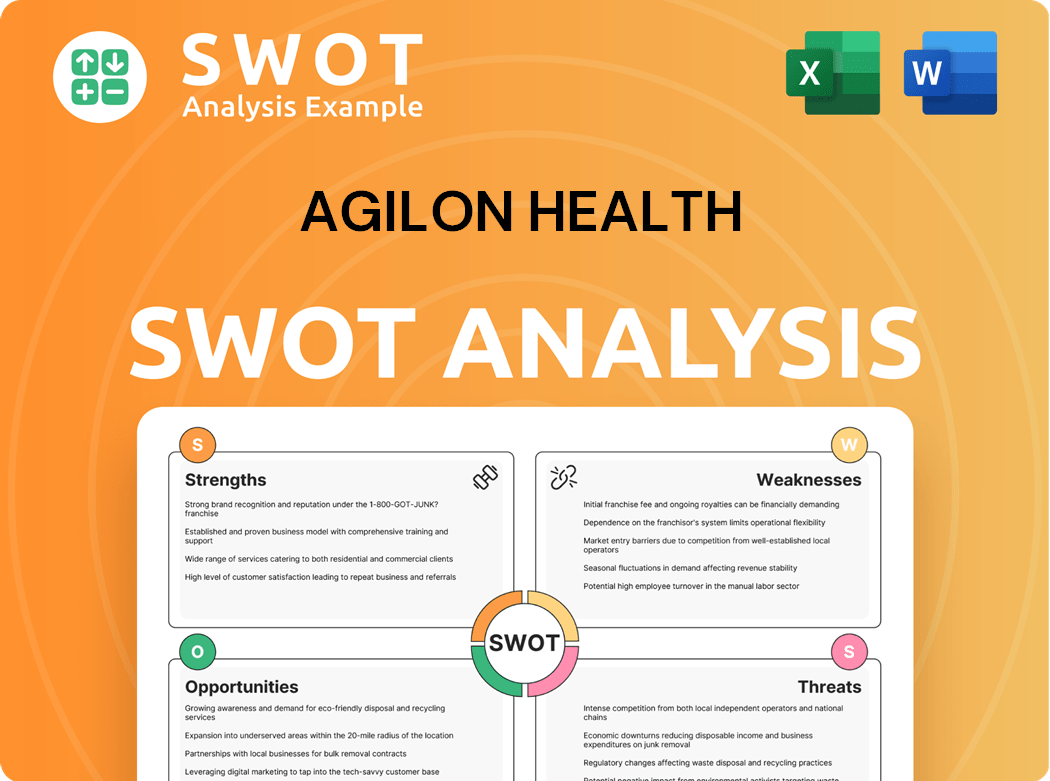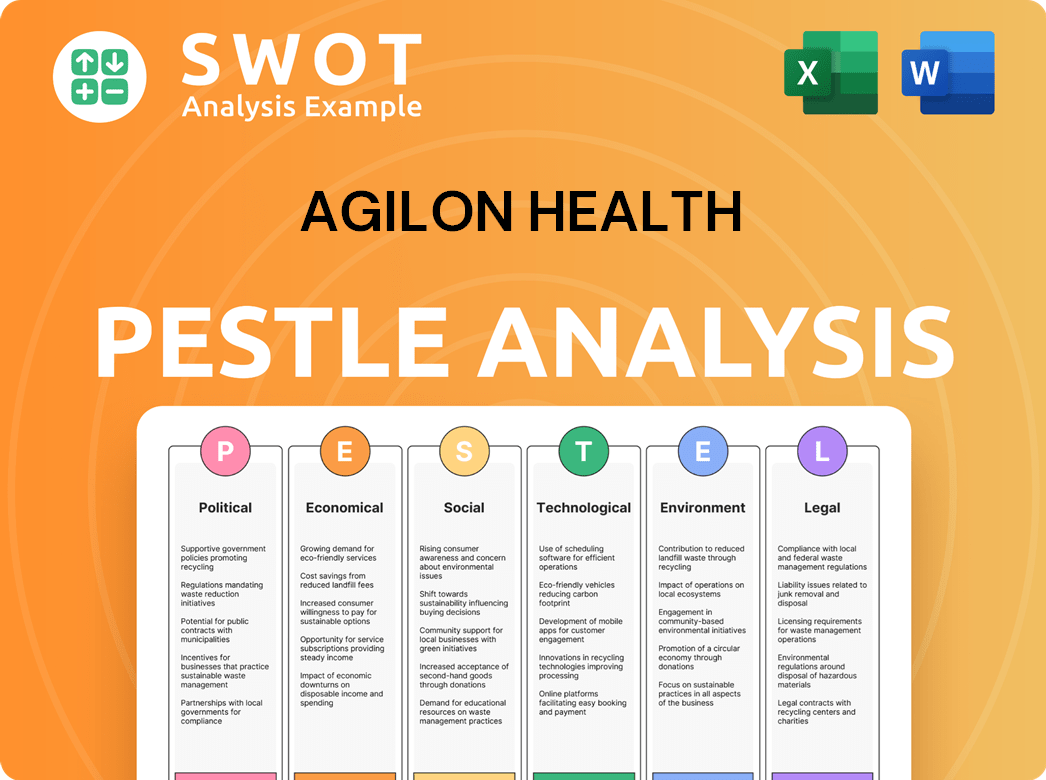agilon health Bundle
How Does Agilon Health Stack Up in the Value-Based Care Arena?
Agilon Health is making waves in the value-based care sector, a healthcare model rapidly gaining traction. With the Centers for Medicare & Medicaid Services (CMS) aiming for widespread adoption by 2030, the stakes are high. This analysis dives deep into the agilon health SWOT Analysis, exploring its position within the competitive landscape.

Understanding the agilon health competitive landscape is crucial for investors and strategists alike. This report provides a comprehensive agilon health market analysis, evaluating its key competitors and dissecting its business model. We'll examine agilon health's financial performance, growth strategy, and the industry trends shaping its future, including a detailed agilon health vs competitors comparison. This includes insights into agilon health's market share 2024, key partnerships, recent acquisitions, and the challenges it faces.
Where Does agilon health’ Stand in the Current Market?
agilon health has established itself as a significant player in the value-based care market. The company focuses on partnering with primary care physicians, primarily serving Medicare Advantage and ACO REACH beneficiaries. This strategic approach is central to its business model, aiming to improve healthcare outcomes while managing costs effectively. For a deeper understanding of the company's origins, you can check out the Brief History of agilon health.
As of March 31, 2025, agilon health's platform supported a total of 605,000 members. This includes 491,000 Medicare Advantage members and 114,000 ACO REACH model beneficiaries. While the total member count saw a decrease compared to the previous year, this was due to previously disclosed market exits, reflecting strategic adjustments in its portfolio.
The company's value proposition centers on its ability to support primary care physicians in delivering value-based care. This involves providing the necessary infrastructure, technology, and resources to manage patient populations effectively. This approach is designed to improve patient outcomes and reduce overall healthcare costs.
In Q1 2025, agilon health reported total revenues of $1.53 billion, a 4% decrease from Q1 2024. This decrease was primarily due to market exits. Despite the revenue decrease, the company achieved a net income of $12 million in Q1 2025, an improvement from a net loss in Q1 2024. The medical margin for Q1 2025 was $128 million.
As of March 31, 2025, agilon health's financial position included $369 million in cash, cash equivalents, and marketable securities. The total debt stood at $35 million. The company's full-year 2025 guidance projects total revenues between $5.85 billion and $6.025 billion.
agilon health's market position is characterized by its focus on value-based care and its partnerships with primary care physicians. The company faces challenges, including profitability concerns and competition within the healthcare market. However, its strategic focus on value-based care and its efforts to improve financial performance are key to its future outlook.
- The company's ability to navigate the competitive landscape and execute its growth strategy will be crucial.
- agilon health's future outlook depends on its ability to sustain and expand its partnerships with primary care physicians.
- The company's success will be influenced by industry trends, including the increasing adoption of value-based care models.
- agilon health is working to improve its financial performance through strategic adjustments.
agilon health SWOT Analysis
- Complete SWOT Breakdown
- Fully Customizable
- Editable in Excel & Word
- Professional Formatting
- Investor-Ready Format

Who Are the Main Competitors Challenging agilon health?
The healthcare industry is highly competitive, and within this environment, agilon health faces a complex competitive landscape. This landscape is primarily shaped by companies involved in value-based care and primary care management. Understanding the key players and their strategies is crucial for assessing the company's position and future prospects.
The competition involves various models, from those focused on specific patient populations to those offering comprehensive care solutions. The market is dynamic, with mergers, acquisitions, and new entrants constantly reshaping the competitive environment. Analyzing these factors provides insight into the challenges and opportunities.
Several companies are key competitors in the value-based care and primary care management sectors.
Privia Health is a significant competitor, offering a technology platform and support services to physicians transitioning to value-based care. The company focuses on enabling physicians to improve patient outcomes and manage costs. Their approach includes a network of providers and a focus on data analytics.
Evolent Health provides population health management services and partners with health systems and physician practices. They offer a range of solutions, including care management, analytics, and value-based care enablement. Their business model supports healthcare providers in managing patient populations effectively.
WellMed Medical Management specializes in providing care for seniors, with a focus on value-based care models. They operate a network of primary care physicians and offer coordinated care services. Their approach is centered on improving the health and well-being of older adults.
Monarch Healthcare is another key player, particularly in managed care and value-based care arrangements. They focus on providing comprehensive healthcare services, often targeting specific geographic regions. Their strategies include building strong relationships with providers and payers.
ChenMed focuses on providing primary care services to seniors, emphasizing a high-touch, patient-centric approach. They operate a network of primary care centers and offer comprehensive care. Their model aims to improve health outcomes and reduce healthcare costs.
Oak Street Health is known for its primary care centers focused on adults on Medicare. They offer a comprehensive care model, including primary care, care management, and social services. Their approach emphasizes preventative care and patient engagement.
Optum, a part of UnitedHealth Group, is a diversified healthcare services company with significant operations in value-based care. They offer a wide range of services, including care delivery, pharmacy care, and data analytics. Their scale and resources give them a competitive advantage.
VillageMD focuses on primary care, partnering with physicians to provide value-based care. They offer a technology platform and support services to help physicians transition to value-based models. Their approach includes a focus on patient experience and outcomes.
Aledade partners with independent primary care practices to help them succeed in value-based care. They offer a technology platform, data analytics, and practice transformation services. Their model supports independent practices in improving patient outcomes and managing costs.
These competitors employ various strategies to gain market share. Some focus on specific patient populations, such as seniors, while others offer comprehensive solutions to a broader range of providers. The competitive landscape is further shaped by mergers and acquisitions, with companies seeking to expand their capabilities and geographic reach. For example, in 2024, there have been several strategic partnerships and acquisitions within the value-based care sector, indicating the ongoing consolidation and competition. The value-based care market is projected to continue growing, with estimates suggesting a significant increase in market size by 2025, further intensifying the competition among these key players. The emphasis on technology, data analytics, and care coordination is a common thread among these competitors, reflecting the industry's shift towards more efficient and patient-centered care models.
Several factors drive competition in this market. These include the ability to manage risk, the strength of physician networks, and the effectiveness of technology platforms. Understanding these factors is essential for a comprehensive
- Value-Based Care Models: The effectiveness of risk-sharing arrangements and the ability to manage patient populations under these models.
- Technology Platforms: The sophistication and usability of technology platforms for data analytics, care coordination, and patient engagement.
- Physician Networks: The size, quality, and geographic reach of the physician networks.
- Relationships with Payers: The ability to secure favorable contracts and partnerships with health insurance companies.
- Patient Focus: The ability to provide patient-centric care and improve patient outcomes.
- Geographic Presence: The extent of the company's reach in different markets and regions.
agilon health PESTLE Analysis
- Covers All 6 PESTLE Categories
- No Research Needed – Save Hours of Work
- Built by Experts, Trusted by Consultants
- Instant Download, Ready to Use
- 100% Editable, Fully Customizable

What Gives agilon health a Competitive Edge Over Its Rivals?
The competitive landscape for agilon health is shaped by its unique focus on value-based care, particularly for seniors, and its collaborative approach with primary care physicians. This strategy sets it apart from many competitors in the healthcare sector. A thorough Owners & Shareholders of agilon health analysis reveals the company's core strengths and how it navigates the challenges of the healthcare market.
agilon health's business model centers on the 'Total Care Model,' which empowers primary care physicians to manage the overall health of their patients within a value-based framework. This model is designed to improve patient outcomes and reduce healthcare costs. The company's strategic initiatives, including technology investments and clinical program enhancements, further strengthen its position in the market.
The company's ability to reduce ER and inpatient utilization compared to local benchmarks is a tangible outcome of its model. This demonstrates the effectiveness of its approach in managing patient care and controlling costs. The company's focus on reducing exposure to Medicare Part D risk is also a strategic move to improve financial performance.
agilon health forms strategic partnerships with primary care physician groups. These partnerships are crucial for expanding its network and reach. The company's success depends on its ability to attract and retain strong physician partners. These partnerships are key to its growth strategy.
The company uses data analytics to enhance care delivery and operational efficiency. This includes analyzing patient data to improve health outcomes and manage costs. Data-driven insights help agilon health make informed decisions and refine its strategies. This is a key aspect of its competitive advantage.
Technology plays a vital role in agilon health's operations, supporting care delivery and administrative functions. Investments in technology are aimed at improving physician onboarding and quality performance. This integration helps streamline processes and improve efficiency. This is a significant factor in its competitive advantages.
agilon health's financial performance is influenced by its value-based care model and risk management strategies. The company actively manages its exposure to financial risks, such as Medicare Part D. The company's focus on financial performance is a key indicator of its success.
agilon health's competitive advantages include its focus on value-based care, its Total Care Model, and its data-driven approach. The company's ability to reduce ER and inpatient utilization is a tangible outcome of its model. These factors contribute to its strong market position.
- Total Care Model: Empowers physicians to manage patient health within a value-based framework.
- Data Analytics: Leverages data to improve care delivery and operational efficiency.
- Strategic Partnerships: Collaborates with primary care physician groups to expand its network.
- Risk Management: Actively manages financial risks, such as those related to Medicare Part D.
agilon health Business Model Canvas
- Complete 9-Block Business Model Canvas
- Effortlessly Communicate Your Business Strategy
- Investor-Ready BMC Format
- 100% Editable and Customizable
- Clear and Structured Layout

What Industry Trends Are Reshaping agilon health’s Competitive Landscape?
The competitive landscape for agilon health is significantly influenced by the broader healthcare industry trends, particularly the shift towards value-based care. The Centers for Medicare & Medicaid Services (CMS) aims to have all Medicare beneficiaries in value-based care arrangements by 2030. This strategic direction creates a substantial opportunity for companies like agilon health that are built on this model. A deeper dive into the Target Market of agilon health reveals further insights into its positioning.
However, the industry presents challenges, including rising medical costs, which affected agilon health's financial performance in 2024 and are anticipated to persist into 2025. The volatility in the Medicare Advantage environment, including changes in utilization and policy, introduces additional risks. Member churn in Medicare Advantage plans also poses a significant hurdle. A thorough agilon health market analysis is crucial for understanding these dynamics.
The healthcare industry is moving towards value-based care, driven by CMS initiatives. This trend favors companies like agilon health. Technological advancements, including AI and data analytics, are playing a bigger role in improving care and efficiency. There is also a growing emphasis on population health management.
Elevated medical cost trends and volatility in the Medicare Advantage environment pose significant challenges. Member churn in Medicare Advantage plans can impact financial performance. Policy changes and shifts in healthcare utilization patterns introduce uncertainty. The need for continuous operational improvements is crucial.
Refining operations and improving medical margins through initiatives like contract repricing and enhanced provider engagement are key. Leveraging technology, including AI and data analytics, to improve care and efficiency creates opportunities. Expanding ACO REACH and MSSP participation can drive growth. Strategic exits from unprofitable partnerships and contracts can strengthen the financial foundation.
The company is focused on improving data visibility and operational efficiency. Emphasis is placed on sustainable growth and strengthening the financial foundation. This involves making strategic decisions regarding partnerships and contracts. Continuous improvement in care delivery and patient outcomes is a priority.
agilon health's success hinges on several key strategies. These include optimizing operational efficiency, leveraging technology, and expanding its value-based care programs. Financial performance is also a critical factor, requiring careful management of medical costs and strategic partnerships. The agilon health business model is designed to capitalize on these strategies.
- Refining Operations: Improving efficiency and cost management.
- Technology Integration: Utilizing AI and data analytics.
- Strategic Partnerships: Focusing on profitable and sustainable collaborations.
- Expanding Value-Based Care: Increasing participation in ACO REACH and MSSP.
agilon health Porter's Five Forces Analysis
- Covers All 5 Competitive Forces in Detail
- Structured for Consultants, Students, and Founders
- 100% Editable in Microsoft Word & Excel
- Instant Digital Download – Use Immediately
- Compatible with Mac & PC – Fully Unlocked

Related Blogs
- What are Mission Vision & Core Values of agilon health Company?
- What is Growth Strategy and Future Prospects of agilon health Company?
- How Does agilon health Company Work?
- What is Sales and Marketing Strategy of agilon health Company?
- What is Brief History of agilon health Company?
- Who Owns agilon health Company?
- What is Customer Demographics and Target Market of agilon health Company?
Disclaimer
All information, articles, and product details provided on this website are for general informational and educational purposes only. We do not claim any ownership over, nor do we intend to infringe upon, any trademarks, copyrights, logos, brand names, or other intellectual property mentioned or depicted on this site. Such intellectual property remains the property of its respective owners, and any references here are made solely for identification or informational purposes, without implying any affiliation, endorsement, or partnership.
We make no representations or warranties, express or implied, regarding the accuracy, completeness, or suitability of any content or products presented. Nothing on this website should be construed as legal, tax, investment, financial, medical, or other professional advice. In addition, no part of this site—including articles or product references—constitutes a solicitation, recommendation, endorsement, advertisement, or offer to buy or sell any securities, franchises, or other financial instruments, particularly in jurisdictions where such activity would be unlawful.
All content is of a general nature and may not address the specific circumstances of any individual or entity. It is not a substitute for professional advice or services. Any actions you take based on the information provided here are strictly at your own risk. You accept full responsibility for any decisions or outcomes arising from your use of this website and agree to release us from any liability in connection with your use of, or reliance upon, the content or products found herein.